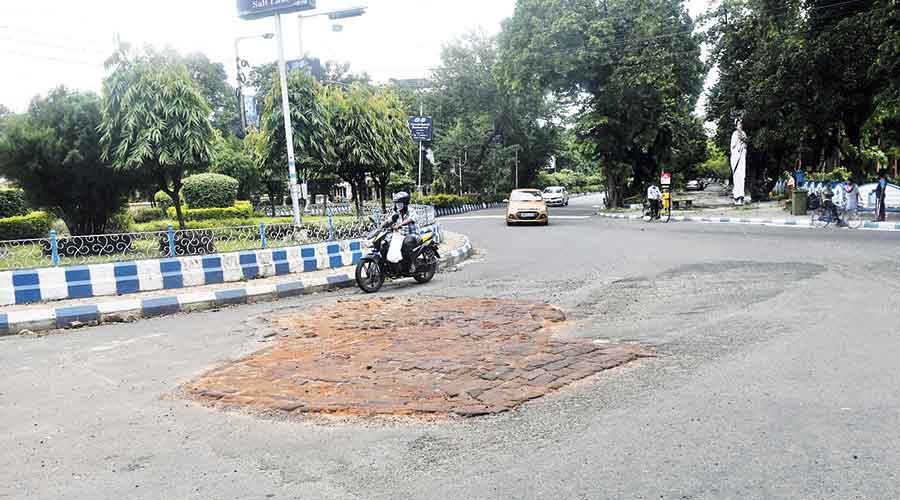The Salt Lake civic authorities carried out patchwork repairs at the intersection of EM Bypass and Broadway, near the Sports Authority of India complex, just a couple of days back. The road surface has already started to wear out.
The 50-m stretch, leading to both EM Bypass from Salt Lake as well as the Salt Lake-bound flank of Broadway, has potholes forming again as the materials used for repairs are being worn out under pressure of moving vehicles.
Metro reported earlier this week how potholes were slowing down traffic, leading to snarls during rushing hours.
“Vehicles invariably slow down in order to negotiate the stretch. The entire area is now littered with stone chips and that pose a risk to commuters,” said a traffic policeman posted at the crossing.
The Bidhannagar Municipal Corporation carried out the patchwork repairs by levelling the stretch with a thin bituminous layer.
A resident of HB block said his car nearly skidded off the road and hit the divider as he slammed the brakes to slow down for the potholes.
“The surface is broken and undulating and takes one by surprise. The bad stretch suddenly appears after a smooth and wide one. On Friday, I suddenly met with an accident,” said Alok Dasgupta, an engineer who stays in HB block.
Another Salt Lake resident said the repairs should have been more thorough. An official of the Salt Lake civic body said patchwork was the preferred mode of repairs because the sanction for an overhaul often came late.
Another official was more forthcoming. Officials do not stand to gain much from a road that lasts long, he said. So, a short-term measure is often the first and the most preferred choice.
“A road surface laid by mastic asphalt or concrete outlasts a surface redone with bitumen, which wears out faster. Every time one bags a contract for repair, he or she has to grease several palms in order to work peacefully. The results are there for everyone to see,” the official said.
The economics of building roads makes mastic asphalt a better choice in the long run, an engineer of the road repairs department of the civic body said.
Around Rs 4 crore is required to create a kilometre of mastic asphalt road. Though the cost is many times higher than patchwork repairs, it evens out in the long run because mastic asphalt doesn’t require frequent repairs.
“A concrete road is three times costlier to build compared with a bitumen stretch of the same length but lasts two decades. The longevity of a bitumen stretch, on the other hand, is a few months. A mastic asphalt road costs double and lasts around five years,” the engineer said.
A contract for patchwork doesn’t have a built-in guarantee period, an engineer of the Salt Lake civic body said. “Cracks or craters can reappear if it rains the very next day and nobody will be liable,” the engineer added.
Tapas Chatterjee, the mayoral council member in charge of roads at the Bidhannagar Municipal Corporation, admitted that patchwork repairs had been carried out a few days ago at the EM Bypass-Broadway crossing but said he had no knowledge that the repairs had started to wear out.
“We did not have the time to shut down entire roads and relay them. So, we did patchwork, which is time-saving. We will carry out thorough repairs soon,” said Chatterjee.











